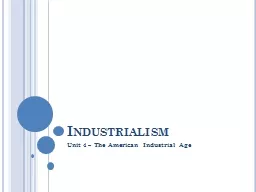PPT-Impact of Industrialism
Author : phoebe-click | Published Date : 2017-07-02
Nature of Work The Cottage Industry homemade goods was replaced by the Factory System machinemade goods Working Conditions Work day was 1216 hours only 1 hr break
Presentation Embed Code
Download Presentation
Download Presentation The PPT/PDF document "Impact of Industrialism" is the property of its rightful owner. Permission is granted to download and print the materials on this website for personal, non-commercial use only, and to display it on your personal computer provided you do not modify the materials and that you retain all copyright notices contained in the materials. By downloading content from our website, you accept the terms of this agreement.
Impact of Industrialism: Transcript
Download Rules Of Document
"Impact of Industrialism"The content belongs to its owner. You may download and print it for personal use, without modification, and keep all copyright notices. By downloading, you agree to these terms.
Related Documents














